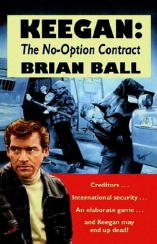July 2007
Monthly Archive
Thu 19 Jul 2007
The latest batch of covers uploaded to Bill Deeck’s Murder at 3 Cents a Day website are those for The William Caslon Company, which in 1936 managed to publish only three mysteries.
All three of these novels would be of special interest to pulp fans, though, as one is a collection of four Red Lacey novelettes by George Bruce originally published in Popular Detective, while the other two are “Dan Fowler” G-Men novels which first appeared in that magazine. A connection with Leo Margulies’ Standard Magazines group of pulp titles seems highly likely.
Even more interesting is the existence of a catalog of forthcoming books from Caslon in 1938, books that were never published, but the titles of which may make you wish they had. These include:
● THE DEVIL’S PLAYGROUND, A G-Man Detective Novel, by John Benton.
● THE CLAIM OF THE LITTLE RED BUGS, A Dr. Lawson Detective Novel, by George Bruce.
● THE MURDER OF A GOOD MAN, A Professor Briarly Detective Novel, by Will Levinrew.
● DEATH WALKS ALONE, by G. Wayman Jones.
And others, including a few westerns, among which are:
● PANHANDLE BANDITS, A Texas Rangers Novel, by Tom Curry.
● JUSTICE RIDES ALONE, by Jackson Cole.
Follow the link above for the complete list.
Thu 19 Jul 2007
SAMUEL HOPKINS ADAMS – Average Jones.
Bobbs-Merrill, hardcover, 1911. Story collection.
As an assiduous reader of personal advertisements — and if you won’t admit to doing the same, I think you’ll agree they are important plot points in a number of detective novels – I warmed instantly to Adrian Van Reypen Egerton Jones, nicknamed Average Jones for obvious reasons.
A highly intelligent, very rich, and terribly bored young man, as the first yarn opens he is wondering what to do with himself. His friend Mr Waldemar, owner of The Universal, an important New York City paper, suggests Jones set up as a kind of one man consumer protection wallah, giving advice, as Jones’s business card will later declare, “upon all matters connected with Advertising.” As a bonus, Jones will pass on discoveries about various swindles perpetrated through ads to Waldemar, thus keeping the paper’s lengthy advertising columns “clean.”
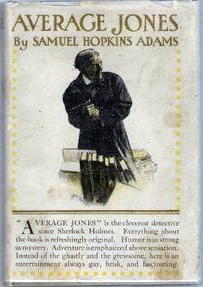
Jones gives it a whirl and soon becomes engrossed in the work to the extent of setting up an agency to handle the more humdrum requests for advice while he looks into ads that grab his attention, particularly those hinting at criminal activity. Average Jones relates the cases he investigates.
“The B-Flat Trombone” is a locked room mystery. By what method was mayoral candidate William Linder blown up in a locked room on the third floor of his mansion on Kennard Street in Brooklyn?
After three unsuccessful attempts on his life, Malcolm Dorr keeps two guard dogs. Both are killed yet neither were shot or poisoned. Then there is a rash of canine deaths in Bridgeport, Connecticut. Is there any connection between these events and the mysterious “Red Dot”?
Where is young rakehell Roderick Hoff? His father engages Jones to find him. Jones follows an “Open Trail” to do so and then outfoxes Hoff’s swindling father when he tries to wiggle out of paying the reward money.
“Mercy Sign” is a dark story rooted in a real historical tragedy. Jones and his friend Robert Bertram look into a strange affair involving a missing academic assistant, a wrecked houseboat, and a dead foreign dignitary.
Jewels nicknamed the “Blue Fires” form a beautiful necklace, a gift from Mr Kirby to his fiancee Edna Hale. Their disappearance means their wedding is postponed. What do a torn curtain and broken-off bed knob have to do with the matter?
Anonymous letters of a particularly nasty sort are written out in “Pin-Pricks” on junk advertising mail sent to William Robinson. What is the purpose of these communications and who could be responsible?
Bailey, the son of rural minister Rev’d Peter Prentice, is missing after a meteor lands on a New England barn and sets it alight. An ad appears revealing he is alive but not where, but a certain bit of “Big Print” aids Jones in tracing the lost boy.
Enderby Livius is “The Man Who Spoke Latin,” claiming he cannot speak English. Livius is up to no good in bibliophile Colonel Ridgway Graeme’s chaotic library, and to find out what it is Jones poses as a mute classical scholar.
“The One Best Bet” begins with a man committing suicide because he arrives too late to amend his personal ad, having had second thoughts about its content – as well he might, since it reveals a plot to murder the governor. Can the crime be prevented?
“The Million-Dollar Dog” involves one of those odd wills beloved by the rich in detective fiction. Judge Hawley Ackroyd’s advertisement seeking l0,000 black beetles puts Jones on the trail of an attempt to gain a fortune by underhanded means.
My verdict: What an inventive way to introduce a detective to cases in all levels of society! I enjoyed this collection a great deal and recommend it to readers who like slightly offbeat and very clever stories. Now I’m off to read the personal ads in today’s papers….
Etext: www.gutenberg.org/dirs/etext04/vrjns10.txt
Besides being a novelist with several works of mystery and detective fiction to his credit, Samuel Hopkins Adams was also a well-known “muckraker” and investigative reporter. For more information on his life and career, a good place to start looking would be his Wikipedia entry.
From Crime Fiction IV, by Allen J. Hubin:
ADAMS, SAMUEL HOPKINS (1871-1958); see pseudonym Warner Fabian.
* Average Jones (Bobbs, 1911, hc) [Average Jones] Palmer, 1911.
* The Flying Death (McClure, 1908, hc) [Long Island, NY]
* _The Mystery (with Stewart Edward White) See entry under Stewart Edward White.
* _The President’s Mystery Story [as by Franklin D. Roosevelt] See entry under Franklin D. Roosevelt
* The Secret of Lonesome Cove (Bobbs, 1912, hc) [New England] Hodder, 1913.
FABIAN, WARNER; pseudonym of Samuel Hopkins Adams.
* -The Men in Her Life (Sears, 1930, hc) Film: Columbia, 1931 (scw: Robert Riskin, Dorothy Howell; dir: William Beaudine).
WHITE, STEWART EDWARD
* The Mystery (with Samuel Hopkins Adams) (McClure, 1907, hc) [Percy Darrow; Ship] Hodder, 1907.
ROOSEVELT, FRANKLIN
* The President’s Mystery Story [by Anthony Abbot, Samuel Hopkins Adams, John Erskine, Rupert Hughes, S. S. Van Dine & Rita Weiman] (Farrar, 1935, hc) Lane, 1936. Revised edition: Prentice-Hall, 1967, as The President’s Murder Plot. A mystery novel suggested by Roosevelt and written, a chapter each, by seven mystery writers. Film: Republic, 1936, as The President’s Mystery; also released as One for All (scw: Lester Cole, Nathaniel West; dir: Phil Rosen).
Thu 19 Jul 2007
Posted by Steve under
Authors ,
Awards1 Comment
LORI G. ARMSTRONG – Hallowed Ground. Nominated for Best Private Eye Paperback Original of the Year, 2007.
Medallion Press, paperback, November 2006.
Book Description:

Grisly murders are rocking the small county of Bear Butte where Julie Collins has spent the last few months learning the PI biz without the guidance of her best friend and business partner, Kevin Wells. Enter dangerous, charismatic entrepreneur Tony Martinez, who convinces Julie to take a case involving a missing five-year-old Native American girl, the innocent pawn in her parents child custody dispute.
Although skeptical about Martinez’s motives in hiring her, and confused by her strange attraction to him, Julie nevertheless sees the opportunity to hone her investigative skills outside her office. But something about the case doesn’t ring true. The girl’s father is foreman on the controversial new Indian casino under construction at the base of the sacred Mato Paha, and the girl’s mother is secretly working for a rival casino rumored to have ties to an east coast crime family.
Local ranchers, including her father, a Lakota Holy group, and casino owners from nearby Deadwood are determined to stop the gaming facility from opening. With the body count rising, the odds are stacked against Julie to discover the truth behind these hidden agendas before the murderer buries it forever. And when Julie unwittingly attracts the attention of the killer, she realizes no place is safe – not even hallowed ground.
About the Author:
Lori G. Armstrong left the firearms industry in 2000 to pursue her dream of writing crime fiction. She lives in Rapid City, South Dakota.
Review Excerpt:
Stephanie Padilla, New Mystery Reader: “Rapid City P.I. Julie Collins is still rather new at the business when she’s hired by bad boy motorcycle leader Tony Martinez to help find his friend’s five year old missing niece. […] If you’re looking for one of those heroines who refrains from any and all vices and who shrieks at the sound of gunfire, you may want to pass on this one. But if you prefer your heroine to be a little on the dark side, especially one who likes to smoke, drink, engage in the occasional sexcapade, and knows how to kick some ass with little fear, this highly engaging and fearless PI fits the bill.”
The first Julie Collins novel:
Blood Ties, Medallion Press, May 2005.
[Coming soon:]
Shallow Grave, Medallion Press, November 2007.
Wed 18 Jul 2007
NICOLAS FREELING – Sabine.
Harper & Row, hardcover, 1976. Paperback reprint: Vintage V-553, 1980. First published in England as Lake Isle, William Heinemann Ltd., hardcover, 1976; Penguin, paperback, 1980.
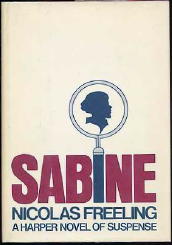
The sights and sounds of small-town France are put on display as provincial policeman Henri Castang investigates the untimely death of an elderly poetess who had earlier come to him with some uneasy feelings concerning her adopted son and only heir. An intellectual affair, in fine Gallic tradition, as we’re shown how political and judicial pressures influence everyday policework, and not at all for the action-minded among us. (C)
– From The MYSTERY FANcier, Vol. 3, No. 2, Mar-Apr 1979. This review also appeared earlier in the Hartford Courant.
[UPDATE] 07-18-07. When I was writing for the Courant, I was usually working under severe space restrictions, so some of my reviews were a whole lot shorter than they are today. I don’t believe I’ve ever read another book by Freeling, I regret to say, neither the Castang books nor the cases given to Inspector Van Der Valk to solve.
Thanks to Crime Fiction IV, by Allen J. Hubin, here’s a list of all of the Henry Castang books. I do have many of these in paperback editions, and just in case you were wondering, I do plan to read them. I don’t keep anything I don’t intend to read.
o A Dressing of Diamond (n.) Harper & Row, 1974.
o The Bugles Blowing (n.) Harper & Row, 1976.
o Sabine (n.) Harper & Row, 1978.
o The Night Lords (n.) Pantheon, 1978.
o Castang’s City (n.) Pantheon, 1980.
o Wolfnight (n.) Pantheon, 1982.
o The Back of the North Wind (n.) Viking, 1983.
o No Part in Your Death (n.) Viking, 1984.
o Cold Iron (n.) Viking,1986.
o Lady MacBeth (n.) Deutsch, UK, 1988. [No US edition.]
o Not As Far As Velma (n.) Mysterious Press, 1989.
o Those in Peril (n.) Mysterious Press, 1991.
o Flanders Sky (n.) Mysterious Press,1992.
o You Know Who (n.) Mysterious Press,1994.
o The Seacoast of Bohemia (n.) Mysterious Press, 1995.
o A Dwarf Kingdom (n.) Mysterious Press, 1996.
Wed 18 Jul 2007
Posted by Steve under
Authors ,
Awards[2] Comments
KRIS NELSCOTT – Days of Rage. Nominated for Best Private Eye Hardcover Novel of the Year, 2007.
St. Martin’s, hardcover, March 2006.
Book Description:
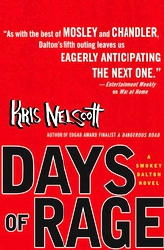
As racial tensions mount during the 1969 celebrity trial of the Chicago Eight, African American PI Smokey Dalton is keeping a low profile with his son, Jimmy, who knows a dark secret about the assassination of Martin Luther King, Jr. When Smokey finds a group of skeletons hidden in the wall of a building hes inspecting for investor Lara Hathaway, his investigation leads him into Chicago’s racist past and implicates some of the nation’s most powerful people in a deadly 1919 riot.
About the Author:
Kris Nelscott [pseudonym of Kristine Kathryn Rusch] lives on the Oregon coast. The first Smokey Dalton novel, A Dangerous Road, won the Herodotus Award for Best Historical Mystery and was shortlisted for the Edgar Award for Best Novel; the second, Smoke-Filled Rooms, was a PNBA Book Award Finalist; the third, Thin Walls, was one of the Chicago Tribune’s best mysteries of the year; the fourth, Stone Cribs, was honored by the Wisconsin Library Association as one of the best books of 2005, and it and the fifth, War at Home, were both shortlisted for the Oregon Book Award. Visit her Web site at www.kristinekathrynrusch.com.
Review Excerpts:
Publishers Weekly: “Set in 1969 during the trial of the Chicago Eight, Edgar-finalist Nelscott’s sixth Smoky Dalton novel (after 2005’s War at Home) deftly interweaves the issue of race with politics, societal questions and personal relationships, like Smokey’s on-again, off-again romance with Laura Hathaway, a white businesswoman. […] Laura and Smokey bring in Wayne LeDoux, a persnickety criminologist, to do forensic work at the house, and Tim Minton, an expert from a local funeral home, joins him. The two men form a special bond, and like the bond between Smokey and his adopted son, make a suspenseful mystery into something much richer.”
Booklist: “In her compelling Smokey Dalton series, Nelscott continues to probe the human drama and complex emotion beneath the headlines of the racially tense 1960s. […] Nelscott builds suspense effectively while making the reader feel the historical burden of racial hatred. After five novels all set between spring 1968 and fall 1969, this series was beginning to seem almost frozen in its historical moment, but this time, Nelscott, by widening the time frame, allows us to see the events of the ’60s – and their devastating effects on individual human lives – from a wider (if hardly comforting) perspective.”
Previous Smoky Dalton novels:
A Dangerous Road. St. Martin’s, hardcover, July 2000. Paperback: June 2001.
Smoke-Filled Rooms. St. Martin’s, hardcover, August 2001. Paperback: June 2002.
Thin Walls. St. Martin’s, hardcover, September 2002. Trade paperback: February 2004.
Stone Cribs. St. Martin’s, hardcover, February 2004. Trade paperback: January 2005.
War at Home. St. Martin’s, hardcover, February 2005. Trade paperback: December 2005.
Wed 18 Jul 2007
Posted by Steve under
Authors ,
AwardsNo Comments
MARCIA MULLER – Vanishing Point. Nominated for Best Private Eye Hardcover Novel of the Year, 2007.
Mysterious Press, hardcover, July 2006. Paperback reprint: July 2007.
Book description:
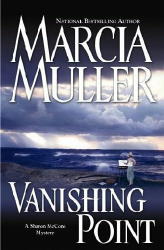
In the latest installment in this critically acclaimed series, McCone is hired to investigate one of San Luis Obispo County’s most puzzling cold cases. A generation ago, Laurel Greenwood, a housewife and artist, inexplicably vanished, leaving her young daughter alone. Now, new evidence suggests that the missing woman may have led a strange double life. But before McCone can penetrate the tangled mystery, she must first solve a second disappearance: that of her client, the now grown daughter of Laurel Greenwood. The case, which forces Sharon to explore the darker sides of two marriages, comes uncomfortably close on the heels of her own marriage to Hy Ripinsky, and she begins to doubt the wisdom of her impulsive trip to the Reno wedding chapel.
About the Author:
Marcia Muller, a Mystery Writers of America Grand Master, is the critically-acclaimed author of more than twenty novels. She has been awarded the Private Eye Writers of America Life Achievement Award, her books have been nominated for Best Crime Novel at the Edgar Awards, and she has won the Anthony Boucher Award. She lives in California with Bill Pronzini.
Review Excerpts:
Publishers Weekly: “MWA Grand Master Muller’s richly layered 24th mystery to feature San Francisco PI Sharon McCone (after 2004’s The Dangerous Hour) reminds us how much McCone has grown since she started as the lone investigator at a poverty law center in her first outing, Edwin of the Iron Shoes (1977). […] The story takes readers on a charming tour through the fishing villages of the California coast, while the tight, crisp plot surges relentlessly forward. The tension between light and dark, between surface happiness and hidden truths, raises this novel well above the common run of whodunits.”
Booklist: “As usual in Muller’s mysteries, dialogue-driven narrative makes the story a quick read, and this time there’s some underlying commentary about marriage, which dovetails nicely with Sharon’s continuing anxieties about her future with new husband Hy.”
Previous Sharon McCone novels: (hardcover editions only)
Edwin of the Iron Shoes. McKay, 1977.
Ask the Cards a Question. St. Martin’s, 1982.
The Cheshire Cat’s Eye. St. Martin’s, 1983.
Games to Keep the Dark Away. St. Martin’s, 1984.
Leave a Message for Willie. St. Martin’s, 1984.
Double. St. Martin’s, 1984. [with Bill Pronzini’s Nameless PI]
There’s Nothing to Be Afraid Of. St. Martin’s, 1985.
Eye of the Storm. Mysterious Press, 1988.
There’s Something in a Sunday. Mysterious Press, 1989.
The Shape of Dread. Mysterious Press, 1989.
Trophies and Dead Things. Mysterious Press, 1990.
Where Echoes Live. Mysterious Press, 1991.
Pennies on a Dead Woman’s Eyes. Mysterious Press, 1992.
Wolf in the Shadows. Mysterious Press, 1993.
Till the Butchers Cut Him Down. Mysterious Press, 1994.
The McCone Files. Crippen & Landru, 1995 [short story collection]
A Wild and Lonely Place. Mysterious Press, 1995.
The Broken Promise Land. Mysterious Press, 1996.
Both Ends of the Night. Mysterious Press, 1997.
While Other People Sleep. Mysterious Press, 1998.
A Walk Through Fire. Mysterious Press, 1999.
Listen to the Silence. Mysterious Press, 2000.
McCone and Friends. Crippen & Landru, 2000. [short story collection]
Dead Midnight. Mysterious Press, 2002.
The Dangerous Hour. Mysterious Press, 2004.
[Newly Published:]
The Ever-Running Man. Grand Central Publishing, July 2007.
Tue 17 Jul 2007
A word of explanation to go with the following review, and any others that will be showing up here on the
M*F blog in the days to follow. These reviews will come from the long distant past, nearly 30 years ago, in fact. All were published in a fanzine published by Guy M. Townsend, and called
The MYSTERY FANcier. I’ll use the initials
TMF in the headings to so indicate where all such reviews first appeared. Prior to their
TMF publication, some of the reviews were appeared in the
Hartford Courant (not a fanzine) and will also be so designated.
I’m going to reprint the reviews as they were published at the time, whatever warts I see they may have when I read them now. I will update the publishing history of the books, and on occasion, perhaps even most of the time, add Updates or other Commentary.
I no longer use letter grades to close up my reviews, but I did back then, and for better or worse, I’ll include them now. Don’t hold me too closely to either my comments or the grades I assigned to the books. I was a different person then, and so (probably) were you.
BRIAN BALL – Death of a Low-Handicap Man.
Arthur Barker Ltd., UK, hardcover, 1974. Walker & Co., hardcover, US, 1978. Paperback reprint: Walker 3063, 1984. Trade paperback: Wildside Press, 2003.
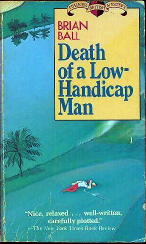
When a golfer that not everyone’s overly fond of is found whacked to death near the clubhouse, the only question the bartender asks is: “How many strokes?” On the other hand, the investigation that follows is painfully and stolidly slow, hampered in part by an unspoken procedural conflict between the village bobby and the superintendent from the C.I.D. Nor is it quite a “locked room” mystery either, but it is difficult to explain how nothing suspicious was noticed, even though the thicket in which the dead man was found had been under close observation throughout the match, and from all sides. Although it’s not really necessary, a love of the silly game of golf will help tremendously in the enjoyment you’ll get from this one. (C)
– From The MYSTERY FANcier, Vol. 3, No. 2, Mar-Apr 1979. This review also appeared earlier in the Hartford Courant.
[UPDATE] 07-18-07. Brian Ball has six books listed in CFIV, as follows:
Death of a Low-Handicap Man (n.) Barker 1974; Walker, 1978.
Montenegrin Gold (n.) Barker 1974; Walker, 1978.
Keegan: The No-Option Contract (n.) Barker, 1975.
Keegan: The One-Way Deal (n.) Barker, 1976.
Witchfinder: The Evil at Monteine (n.) Mayflower, pb, 1977.
The Baker Street Boys (co.) BBC, 1983. Series character: Arnold Wiggins. [Two novelettes based on the BBC television series.]
He’s probably much better known, however, as science fiction writer Brian N. Ball. For a list of all of his books, this website seems to be the place to look.
Keegan appears to have been a reluctant spy for British Intelligence. The book based on “The Baker Street Boys”sounds intriguing, as does the TV series itself. The link will lead to the IMDB entry for it. There was one other book in the “Witchfinder” series:
Witchfinder: The Mark of the Beast. (n.) Mayflower, pb, 1976.
While this may be a book wrongly omitted from CFIV, it may be a straight horror novel with no criminous aspects to it.
As for the mystery novel reviewed above, I seem to have neglected to include the name of either of the two sleuths involved, not that either apparently made another appearance. Nevertheless, I’d still like to know who they might have been. If you happen to have a copy handy, would check it out and pass the word along to me?
The “locked room” aspect doesn’t seem to have been strong enough for the book to be included in Bob Adey’s Locked Room Murders, but once again, my bringing it up at all makes me wish I’d taken better notes at the time. Even though I gave this one a letter grade of only a “C”, if I come across it again any time soon, I think that a re-reading might very well be in order.
Tue 17 Jul 2007
ERLE STANLEY GARDNER – The Case of the Terrified Typist
Pocket 6108, paperback reprint; 1st printing, November 1961. Hardcover edition: William Morrow, January 1956. Detective Book Club [3-in-1 edition], February 1956. Other paperback editions: Pocket Cardinal C-275, August 1958. Pocket, 1967, October 1975. Ballantine, March 1987, July 1999. Other editions are likely.
There are certain authors who are so well known that there is very little chance that a review of one of their books is going to convince a would-be reader to read that author or not, even if that would-be reader has never even read that author. Sometimes one’s mind is made up, and there’s nothing that I could say that could change their opinion, either one way or the other.
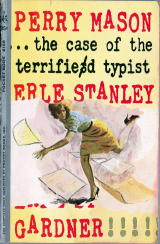
Case in point: Erle Stanley Gardner, and in particular the Perry Mason stories that he is known around the world for writing. In an unusal split in personality, fiction-wise, a number of people say that they like Gardner in his guise as A. A. Fair, but not when he’s writing under his own name, but stylistically, they read the same to me.
I recognize, of course, the various reasons why someone might not care for Gardner’s books. Maybe you (well, not necessarily you) don’t like courtroom dramas, especially those that you know pretty much when the courtroom scenes are going to take place, soon after about halfway through, with a break in the action while the courtroom’s in recess while Perry calls on his stalwart private eye Paul Drake to dig up the necessary evidence he suddenly realizes that he needs.
Those readers who like their detective figures to have personal lives have little to look forward to in the Perry Mason books. What do Perry and his faithful secretary do after their frequent dinners out together? It was never said, and it never will be. Gardner’s narratives and the dialogue from the mouths of his characters are of one piece, wooden, for the most part, and I suspect, repetitive in cadence and phrasing from book to book.
I recognize all of the above, and groan sometimes when an especially awkward bit of repartee between Perry, Paul and Della takes place, and sometimes — believe it or not — the clueing is not entirely is as seamless and tidied up as completely at the end as it should be. But once started one of the Perry Mason books, I simply cannot stop.
They usually begin with some strange, unusual occurrence that somehow happens to Perry or catches his eye in the newspaper or from his incoming mail, and The Case of the Terrified Typist is certainly no exception. Needing an ultra-efficient typist for some reason, Perry’s office is expecting one from an employment agency. When she arrives, she is very nervous, but she also proves to be one of the best typists they’ve ever had — until she disappears.
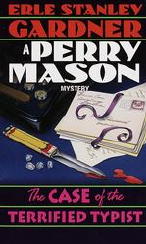
Until another office — a jewel importing firm — in the same building is found to have been vandalized. Until a wad of gum under the typist’s table is found to be concealing two diamonds. Until Perry is hired by the firm’s head office to represent one of the two men in charge of the local branch — he’s accused of killing the smuggler who brought the gems into the country but whose body has never been found.
Twist after new revelation after twist occurs, and trying to keep track of all of the participants and who’s telling the truth and who’s not will simply make one’s head swim. I know. It did mine. This is also one of the few cases in which Perry’s client is found guilty, until of course, the final twist and the final revelation that I guarantee you no one — no one, I tell you — no one will see coming, unless they just happen to have had their eyes fixed on the shell that contains the pea all along.
That is to say, one of the participants is telling the truth and the whole truth, and maybe if you identify which one of them it is, you will have a chance of pulling this one out. As for me, I never came close.
— July 2007
[PostScript] It was a coincidence only, but I’d just finished writing this review and was in the process of editing it when I saw on Bill Crider’s blog that today’s the 118th anniversary of Erle Stanley Gardner’s date of birth. He was born on this day in 1889.
So the review was rushed into (electronic) print, with some of the rough edges still showing, since smoothed away, I hope. For a fine overview of Gardner’s career as well as that of Perry Mason, you could do no better than visit The Rap Sheet, where Jeff Pierce discusses in great detail Ken Corning, Mason’s early counterpart in Black Mask magazine; the 1930s movies Mason was in; and above all, the superb choice made in casting Raymond Burr as Perry Mason, and in doing so, transforming the character into one of the immortals in the history of detective fiction.
Tue 17 Jul 2007
RHYS BOWEN – In Like Flynn
St. Martin’s; paperback reprint, December 2005. Hardcover edition: St. Martin’s Press, March 2005.
I’ll defer to Ms. Bowen’s website for most of the data about her, including the fact that her books have been nominated for “every major mystery award – Edgar, Agatha, Anthony, Barry, Macavity – and has won seven of them.” Thanks to Crime Fiction IV, however, it can be learned that her real name is Janet Quin-Harkin. Ms. Bowen started writing mysteries later than usual in life; her first one was Evans Above, part of the Evan Evans series, and was published in 1997 when the author was 56. [FOOTNOTE.]
From her website, here’s a list of all of the books in each of her two series:
The Constable Evans Series: [All St. Martin’s Press in hardcover; Berkley Prime Crime in paperback.]
Evans Above, 1997
Evan Help Us, 1998
Evanly Choirs, 1999
Evan and Elle, 2000
Evan Can Wait, 2001
Evans to Betsy, 2002
Evan Only Knows, 2003
Evan’s Gate, 2004
Evan Blessed, 2005
The Molly Murphy Series: [St. Martin’s Press in both hardcover and paperback.]
Murphy’s Law, 2001
Death of Riley, 2002
For the Love of Mike, 2003
In Like Flynn, March 2005
Oh Danny Boy, March 2006
The Constable Evans series take place in Llanfair, Wales, and are contemporary in nature. The Molly Murphy books, on the other hand, are historical mysteries, Manhattan-based, and take place just after the turn of the last century. Naturally it goes without saying, but I’ll say it anyway: I’ve just read the fourth book, and none of the first three.
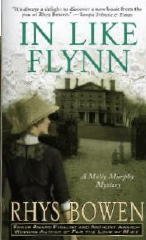
What that means, in other words, is that there is a lot of backstory that has developed through the course of the three before this one, and there are a number of characters to be introduced to, all in a hurry. If you take all in stride, however, it doesn’t take too long to fill in most of the salient details. Suffice it to say, perhaps, that Molly Murphy is a recent immigrant who has improved her status in her new world to become one of the few female private investigators in that particular time and place. On page 12 she also admits to having been an artist’s model, comfortable in posing in the nude before strange men, which of course is an eye-opener, and equally of course I can only believe her.
In any case, Miss Molly Malone is about as progressive as you could possibly get, in that particular time and place, and her love life and home life are equally eyebrow-raising, figuratively speaking. She is all-but-spoken-for with one man, she shares her home with another, and the man she really loves (it seems) is her ex-beau, Captain Daniel Sullivan of the New York Police.
Much of this background, once the new reader has found some solid ground upon which to stand, turns out to be unnecessary in a way, since the case that Molly undertakes this time around takes her to a mansion up along the Hudson, where her task is twofold: (1) to investigate the authenticity of two females mediums who have been preying upon wealthy people who have lost loved ones, and (2) and Daniel Sullivan does not know this, to investigate the kidnapping and subsequent disappearance (and assumed death) of a young child born to Senator Barney Flynn and his wife.
And what this means is working undercover as an unknown cousin of the senator’s, visiting from Ireland – and hence the title. What Molly does not know that this also means meeting someone from her recent past, someone whom she expected never to see again, as well as keeping her wits about her in solving the case without blowing her cover. Taking advantage of some rather limited opportunities, she does a capable enough job of investigating – enough so that the truth, in long-winded fashion (the book is over 320 pages long), does come out. Investigating, that is, in the sense of Nancy Drew, reacting rather than acting, and with little sense of doing any real deducting.
It is a fine piece of writing, though, you should certainly not get me wrong, with quite a few serious insights into who people are and why they are that way. Once again, I should not lead you astray by saying what the book is not, as opposed to what it is, and what it is, is fine indeed. The ending also contains a considerable enticement to read the next one, to see what comes next for Molly Malone and her somewhat embattled (and bewildered) policeman friend.
FOOTNOTE. Ms. Bowen addresses this point in a short autobiographical section that she’s included on her website: “Children’s books, young adult books, adult historical romances and sagas followed [working for the BBC and Australian broadcasting] until I decided it was finally time for me to write what I enjoyed reading most … and that was mysteries.”
Tue 17 Jul 2007
Posted by Steve under
Authors ,
Awards[2] Comments
KEN KUHLKEN – The Do-Re-Mi. Nominated for Best Private Eye Hardcover Novel of the Year, 2007.
Poisoned Pen Press, hardcover, November 2006.
Book Description:
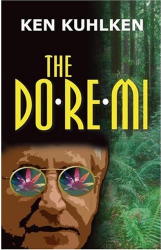
It’s late summer, 1972, up in California’s redwood forests. They seem a “safe and wondrous place,” but some of Evergreen’s population is growing pot up in the trees and others are bent on stealing it. Then there’s the coming folk festival, a jamboree bringing in musicians, fans, war protestors – a ferment of flower power (the local hippies), raw power (the local biker gangs, notably the Cossacks), and the power of the law (local and federal). Skirting the edges are shades of the Manson Family and the Mexican Mafia.
Clifford Hickey, scheduled to perform a guitar gig at the festival before trucking off to law school, arrives at his brother Alvaro’s peaceful woodland campsite. And within moments Alvaro, combat trained, is faced with six armed men in badges crashing the camp, and runs. Clifford, surprised, is arrested and brutally cuffed, so brutally he fears for his hands. He then learns that a young man, one of the sheriffs’ nephews, has just been murdered. Alvaro is the posse’s quarry.
So here’s Clifford, on the brink of adult life, pitched into not just a murder but what develops into a duel between the Hickeys – for his father [PI Tom Hickey] and mother soon drive up – and the law, between the Hickeys and the Cossacks – who seemingly have their own agenda for Alvaro and, between the Hickeys and the locals, and finally between the Hickeys and their own past.
About the Author:
Ken Kuhlken is a compulsive storyteller who drifted from his home in the southwest to the University of Iowa to study in its Writers’ Workshop. After publishing a story in Esquire, he believed he was golden. But the world proved to be a rougher arena than he’d foreseen, and he drifted through eight colleges teaching writing. Meantime, he fathered three amazing children and did three years as a newspaper columnist.
Review Excerpts:
Publishers Weekly: “Clifford [Hickey] must try to prove his brother’s innocence in a town filled with vengeful bikers, suspicious locals, crooked cops, rogue federal agents and pot-growing hippies. Kuhlken brings the social and cultural scene of the period vividly to life.”
Booklist: “Trapped in a battle between the law, rival biker gangs, the locals, and his own family, Clifford has an intricate puzzle to solve. Readers will enjoy this tale, which captures the history and atmosphere of 1970s California as well as the complex dynamics of a fascinating family.”
Dick Adler, Chicago Tribune: “…thoughtful and exciting…. Among its other virtues, it captures summer 1972 and its motley crew – outlaw bikers, war protestors, marijuana growers and users – to understated perfection.”
Previous Tom Hickey novels:
The Loud Adios. St. Martin’s, hardcover, August 1991. Trade paperback: Poisoned Pen Press, November 2006.
The Venus Deal. St. Martin’s, hardcover, April 1993. Trade paperback: Poisoned Pen Press, May 2007.
The Angel Gang. St. Martin’s, hardcover, August 1994.
« Previous Page — Next Page »







